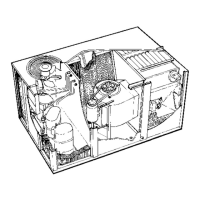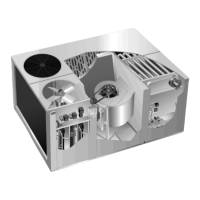Page 46
4-Economizer Operation
a-Enthalpy Control: Setpoint Control
The key to economizer operation is the enthalpy
control. The enthalpy control senses the total heat
content of the outside air (temperature plus humid
ity) and uses that information to control the amount
of outside air brought into the system. When the en
thalpy of the outside air is below the control setpoint,
the control actuates a motor which in turn adjusts
the outdoor dampers to meet the cooling demands
of the building. When the heat content rises above
the control setpoint, the control deactivates and the
dampers close to the preset minimum (not closed)
position.
FIGURE 48
ENTHALPY CHART
CHART
CURVE
CONTROL
POINT 50% RH
F C
A
B
C
D
73
70
67
63
23
21
19
17
Two types of adjustment may be made at the con
trol. The first is the control setpoint. The setpoint de
termines the temperature and humidity conditions
at which the outdoor air dampers will open and
close. The recommended setpoint is A." If the
economizer is allowing air which is too warm or too
humid into the system, the control may be changed
to a lower setpoint (B,C or D). Refer to enthalpy
chart figure 48.
Example:
If the enthalpy control is set at setpoint A" as shown in
figure 48, the following situation could occur. A cooling
demand when the outside air is at 75 and 20 percent
humidity would drive the economizer outdoor air
dampers open to utilize outdoor air for cooling. The
compressor cooling circuit would be disabled. Howev
er, if the outdoor air should change to 70F (a drop in
temperature) and 70 percent humidity (a dramatic rise
in humidity), the total heat content" of the outdoor air
would rise above the enthalpy control setpoint and de
activate the damper motor to the preset minimum posi
tion. If cooling demand is still present when the total
heat of the outside air rises above the control setpoint,
cooling demand is routed from the economizer to the
compressor cooling circuit.
b-Minimum Positioner
The second type of adjustment which may be made
at the control is the minimum position of the outdoor
damper blades. Each economizer has a minimum
positioner switch (potentiometer) which allows the
outdoor dampers to be adjusted to a preset mini
mum position. This allows a preset amount of air
exchange at all times during unit operation. When
unit operation stops, the dampers drive fully
closed. The potentiometer is located on the en
thalpy control face (modulating economizer) or on
the damper motor (three position economizer.)
c-Enthalpy Sensor
The enthalpy sensor is located on the outside por
tion of the outdoor damper blades (as shown in fig
ure 49). The sensor monitors the total heat content
of the outdoor air (temperature plus humidity) and
sends the information to the enthalpy control. The
enthalpy control uses the information to determine if
outdoor air can be used for cooling.

